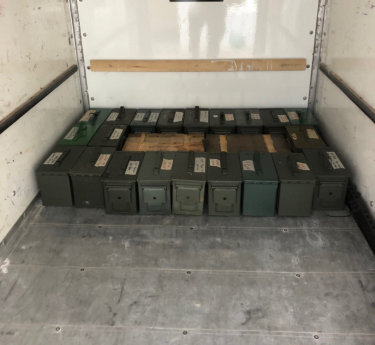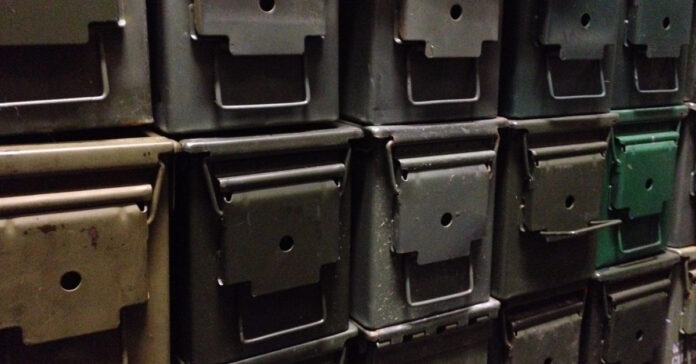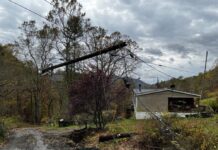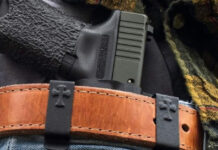While watching football this weekend, I started doing an inventory of the ammo cans in my storage room. At every commercial break, I’d haul two out, open them up and check the contents. They broke down into two categories.
Single Caliber
More than fifteen years ago, our basement experienced a minor flood when the hot water tank failed and some of my ammo got wet. The water soaked through cardboard boxes. After that, I started storing all my ammo in .50 caliber ammo cans. I bought most of these surplus, cleaned out the rust and repainted them. When the cost of surplus cans exceeded $10, I started buying new cans.
Many of my cans contain a single caliber of ammo. I have multiple cans of .223, 5.56, .308, .300 Blackout, .22LR, 12 gauge and .40S&W and 9mm. I have single cans of .45ACP, .45 Long Colt, .38SPL.
Most of the 5.56 is on stripper clips. Sometimes I could buy Federal 193 on stripper clips, but I often loaded them myself. Some cans had old surplus cloth bandoleers and cardboard inserts that hold 15 stripper clips, enough to reload five 30-round magazines. Most of these have a spade, the device used to fit the stripper clip to the magazine, attached to the bandolier by an old safety pin. When set up this way, I could fit 600 or 750 rounds into an ammo can. Then I would squeeze an empty magazine or two on top.
I would also toss in a random accessory of some sort. This included inexpensive shooting glasses, cheap folding knives, bore snakes, gun oil and tubes of grease, MRE cookies, and MRE nut and raisin mixes. One can even contained a roll of pre-1965 silver dimes. (Score!)
In a similar vein, I had a can that included 600 rounds of .40S&W and two Glock magazines while another can held 2,500 rounds of .22LR and two Ruger 10/22 magazines.
Grab and Go Cans
My Grab and Go cans contain a mixture of calibers and were intended to be grabbed on the way out of the house. This would ensure I had spare ammo for whatever gun was on my person, in my car, and carried by my wife. Before we moved to our permanent prepper place, I stored these in the garage and could toss them into the car or truck as we bugged out.
No two of these cans were alike. Here’s what one can held: 400 rounds of 5.56, 50 rounds of .40S&W, 50 rounds of 9mm, 50 rounds of .22LR, 1 Glock magazine, 1 neck knife. Other cans had .38SPL ammo and 12 gauge, but almost all included 5.56 and .40, which would be my standard load out. Today, that has changed a bit and might include .300 Blackout instead of 5.56.
You can see that I almost always included a spare magazine or two. My thinking was, if we needed our emergency ammo, we would appreciate having spare magazines. Even if you train on tactical reloads and plan to hang on to your empties, it may not work that way when someone is shooting back.
One advantage of having prepped for decades is I accumulate preps and don’t always realize it. For example, I had 21 AR-15 magazines distributed across my ammo cans. That’s quite a few magazines I hadn’t accounted for.

No More Bugging Out
I packed all of these cans before we moved to our prepper property. When we moved two years ago, I just grabbed the cans and packed them in a trailer. I didn’t pay attention to what was inside them.
Now that we live halfway up a mountain in the middle of nowhere, we do not intend to bug out. Hopefully, we won’t have to grab a can of mixed ammo and head for the hills. Nevertheless, I can see some advantages to burying two or three ammo cans on the mountain as a cache.
Instead, I decided to borrow a concept from Bear Independent and create a Homestead Defense Bag. Rather than sustaining you while you bug out, this bag provides what you need to defend your homestead if all hell should break loose. I look at it as the bag I grab when I grab my rifle and run out the back door to avoid whomever is coming up the road or down my driveway.
Homestead Defense Backpack Contents
Here’s what’s in my 5.56 bag. I plan to make up a .300 blackout bag as well. The ammo will be the major difference between the two.
- Four loaded rifle magazines. With what is on my gun and battle belt, this should give me 8 to 10 loaded magazines
- One bandoleer of 150 rounds
- One loaded Glock 22 magazine
- A fixed blade knife, to be switched to my belt if time allows
- One 20-ounce bottle of water
- An empty water bladder to fill in the field as needed
- 1 survival straw or similar water purification device
- 1 packet of water purification powders
- A Kleenex packet
- Two Snickers bars, two nut packets, two Slim Jims, a packet of MRE cookies, and a small bag of M&Ms.
- A camouflage boonie hat
- A pair of hiking socks
- Tactical gloves
- A shemagh and a bandana
- A large trash bag
- Paper and pencil
- Extra battery that fits my EDC light
- Small med kit
- A bore snake and a tiny tube of lube
Light and Lean
This bag is primarily ammo replenishment and some quick energy food to keep me going. It’s light, so I can move quickly.
You will note the kit does not include any weather-appropriate clothing. I’d like to include a GI poncho, but I don’t have enough spares. If it’s raining, I’ll try to grab one on the way out. If it’s cold, I’ll grab a parka.
The bag does not include a bivvy sack or any other overnight gear. If I’m out at night, I expect to be observing, shooting and scooting, or on the move rather than sleeping. Likewise, I don’t have a fire starter kit because I don’t intend to start a fire. A fire will draw the enemy. My EDC includes a lighter, but it would have to be an emergency to break it out in this scenario.
It also does not include binoculars, a monocular, or any other magnified optics. This is because my primary rifles have magnified optics. If I need to do any observing, I’ll use these. Also, our mountainous terrain does not lend itself to distant observation. The trees are so heavy, I won’t have the opportunity to look at something 500 yards away. If I observe the house, I’ll have to do so from fairly close.
Bore Snakes
You might have noticed that I like bore snakes. I am not convinced they are the best way to clean your gun, but I believe they are an excellent way to quickly clean the bore when time allows. Unlike a cleaning rod, they don’t allow you to remove a stuck round, but I’ve been shooting for 30 years and I’ve never had a round stuck in the bore. I’ve only seen one person at a match have a cartridge stuck in his gun that had to be pushed out from the bore. I guess it’s a risk I’m willing to take.
At least a decade ago, I bought several dozen Bore Snakes on one of those Chinese websites that seem to sell everything. I don’t know if they fell off the loading dock, were factory rejects, or outright counterfeits, but they looked good and worked just fine. I still have some unopened ones. Regardless of where you buy yours, I recommend them as part of your cleaning regimen.
Key Takeaways
This article should serve as a reminder to stockpile ammo as well as food. If you do, I recommend using ammo cans for their waterproof seal and the convenient handle. Consider making up “Grab and Go” cans that include your most important calibers and a spare mag or two. Position them somewhere convenient sp you can quickly load them up if you have to bug out
Once you get to your retreat, or if you are lucky enough to live there already, consider putting together your version of a Homestead Defense Pack.
To read Pete’s thoughts on bugout bags, check out The Dirty Little Secret about Bugout Bags.








